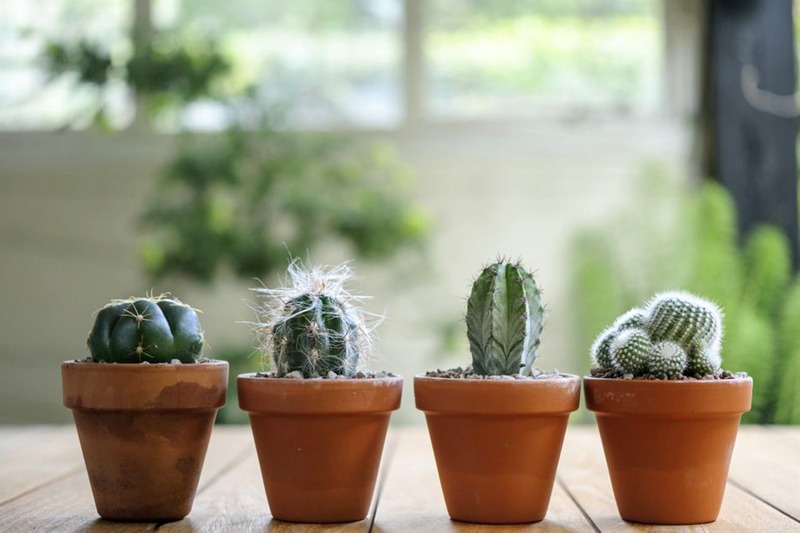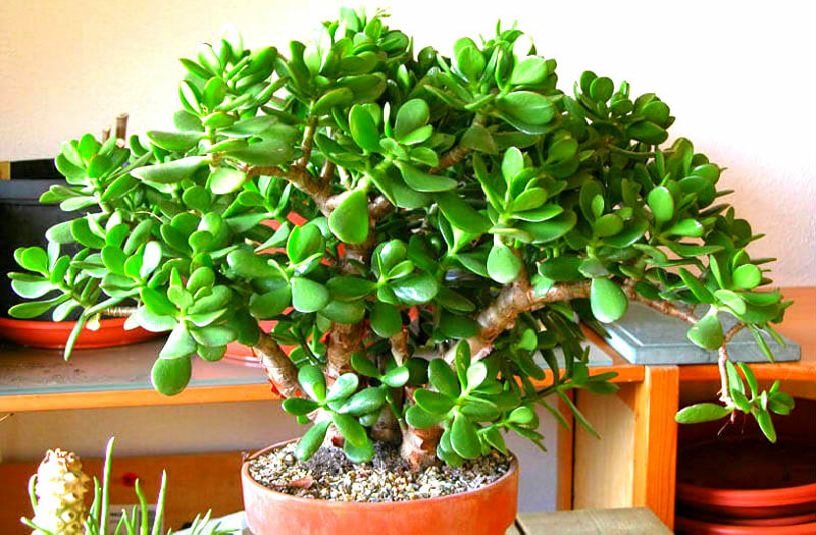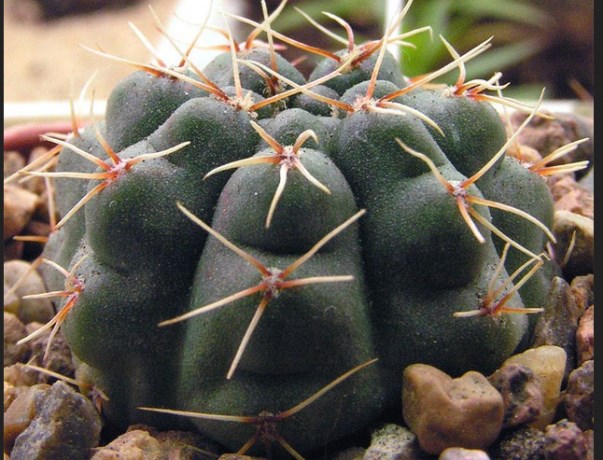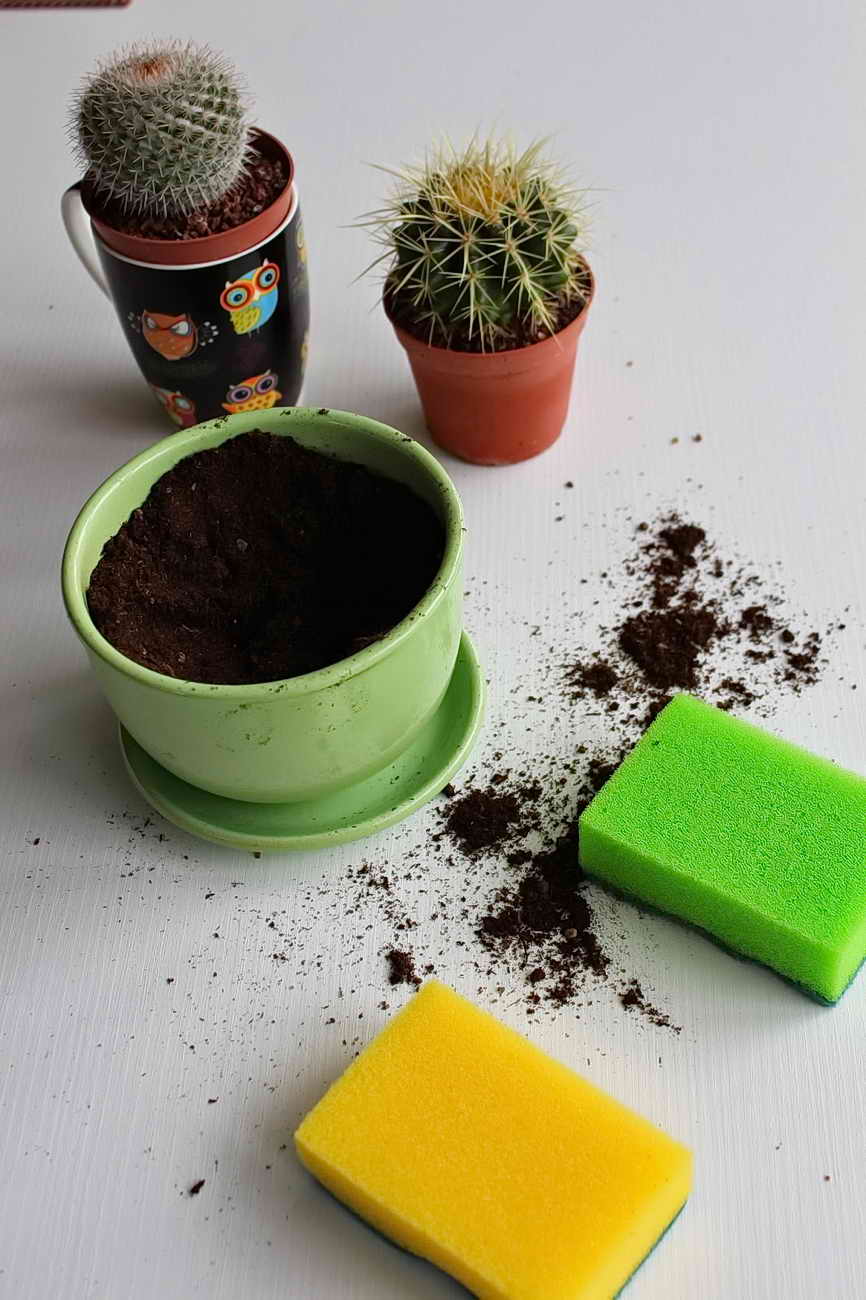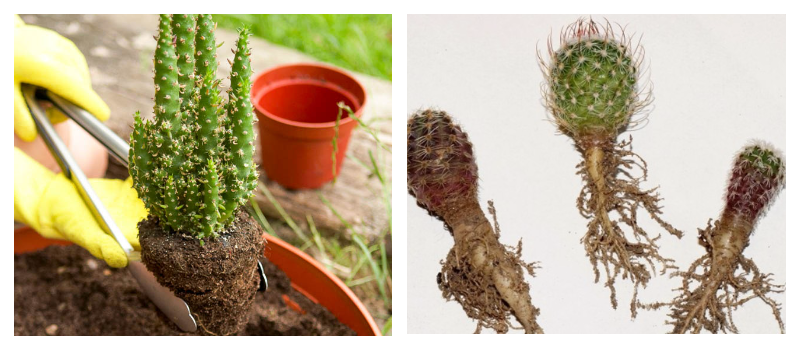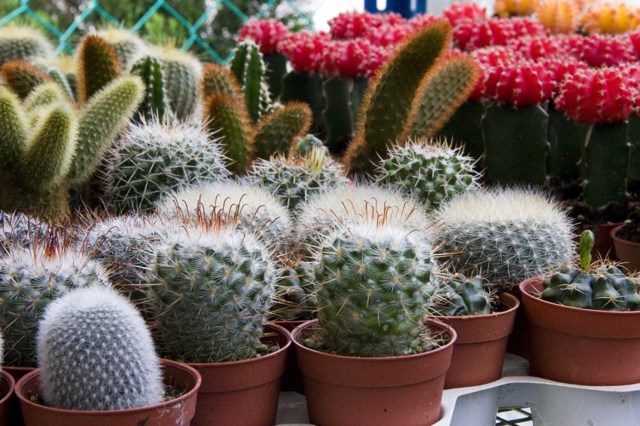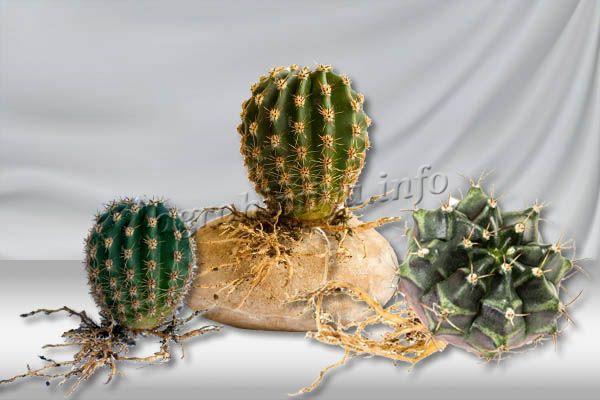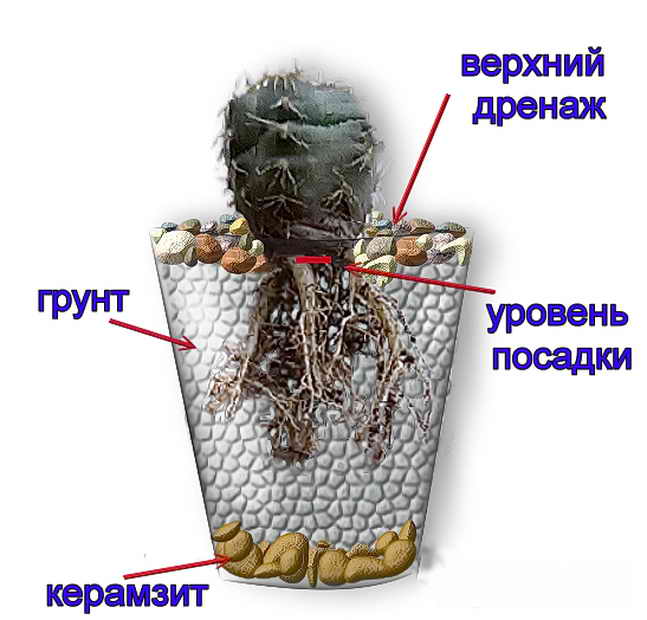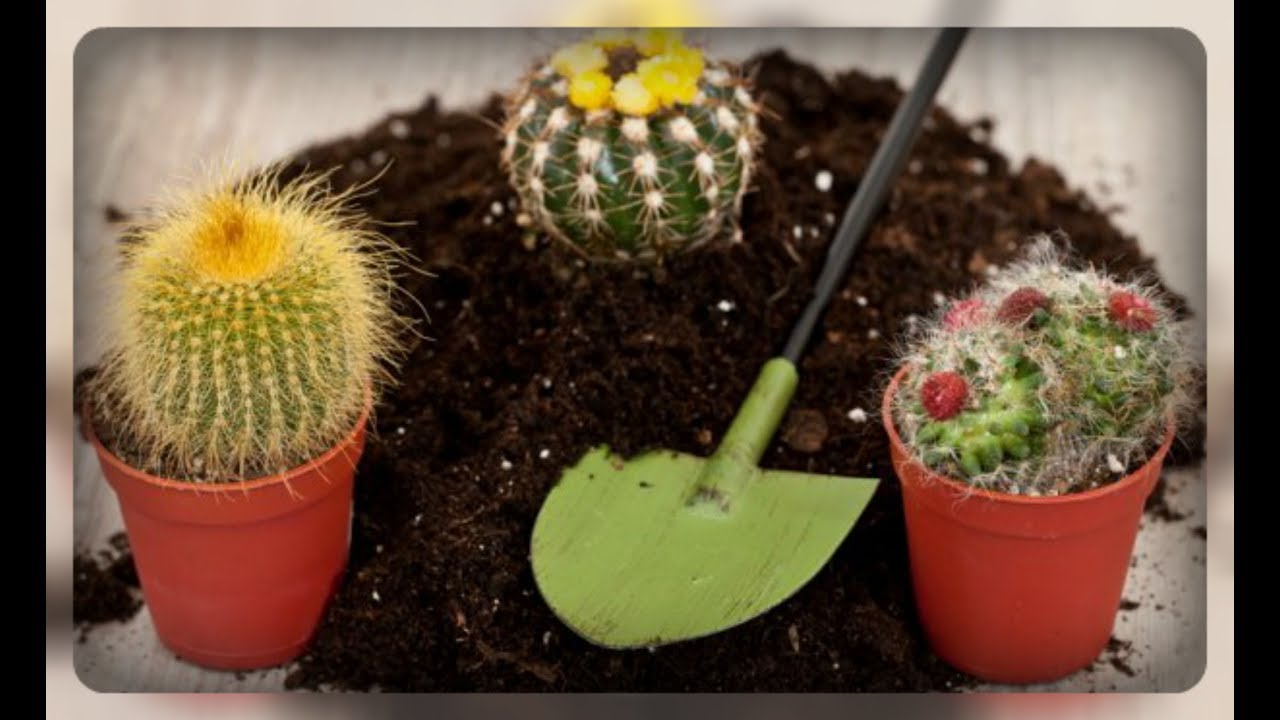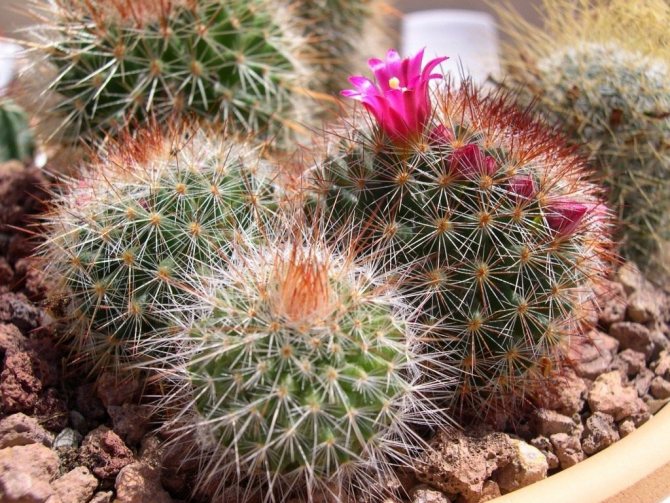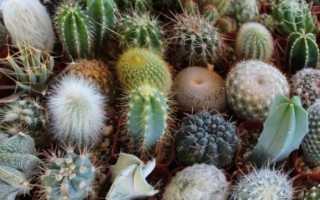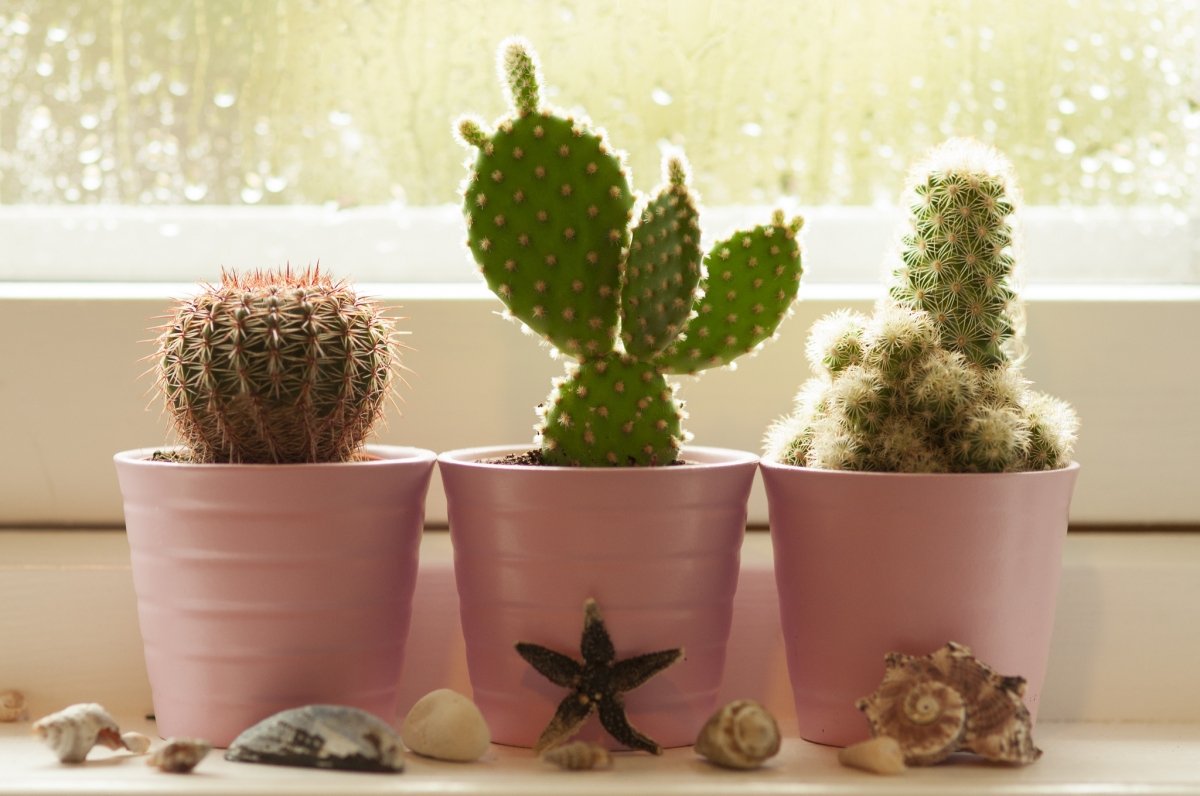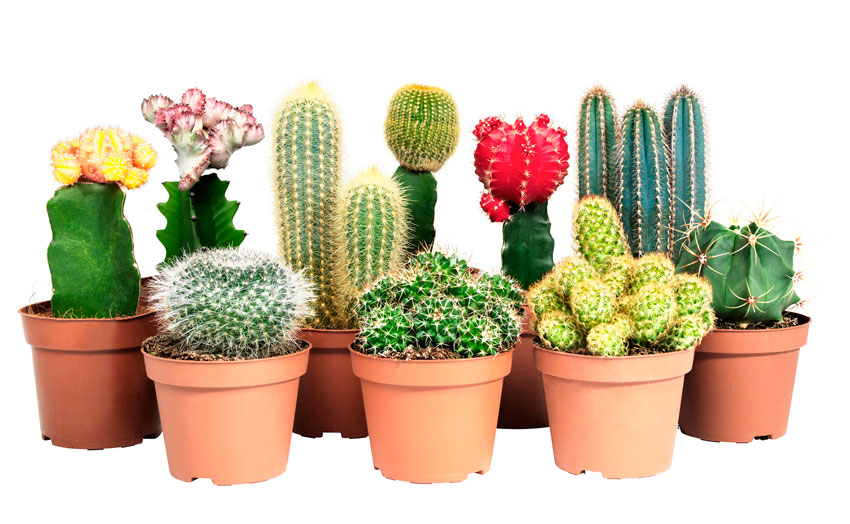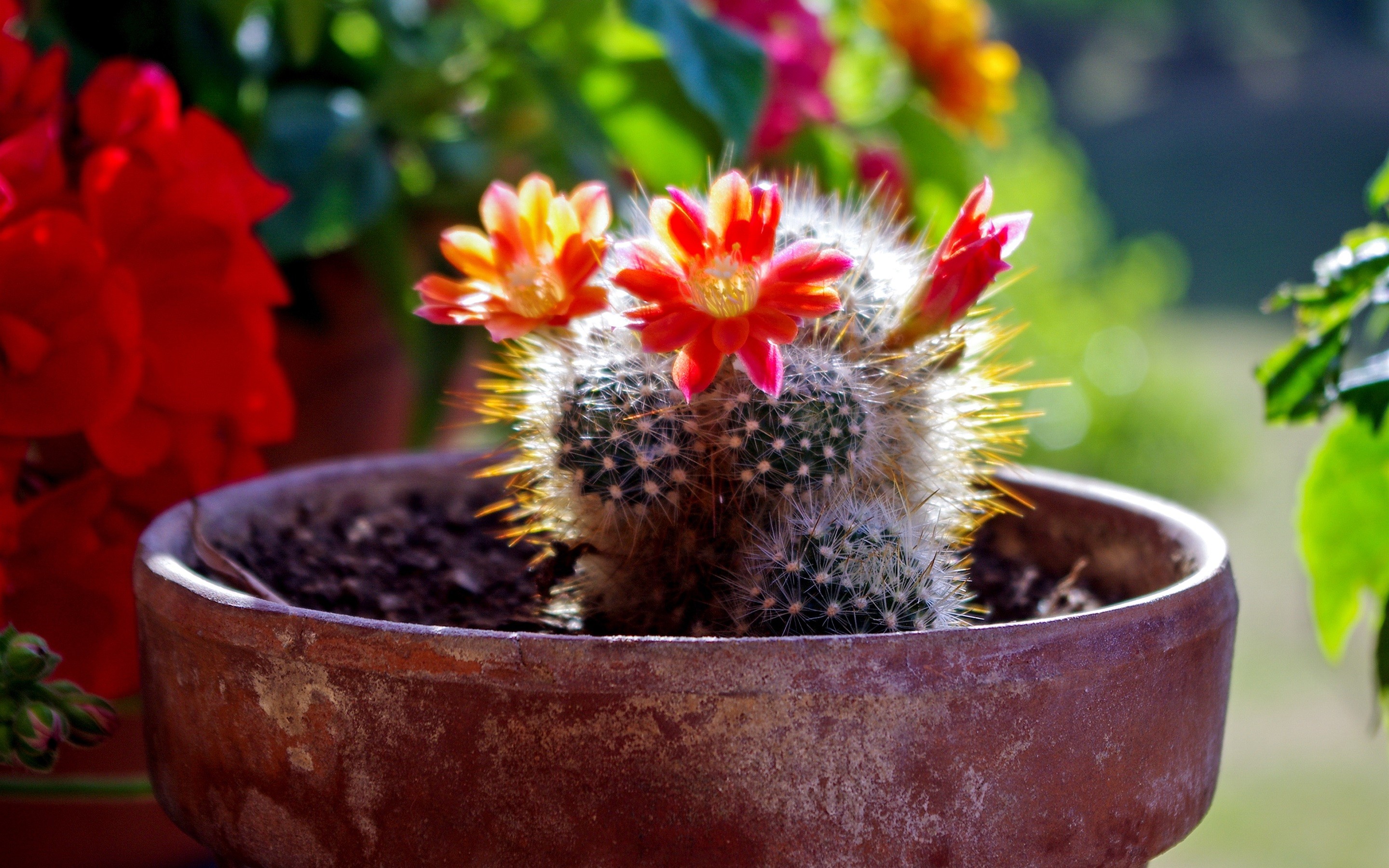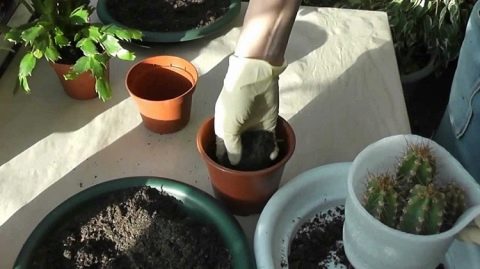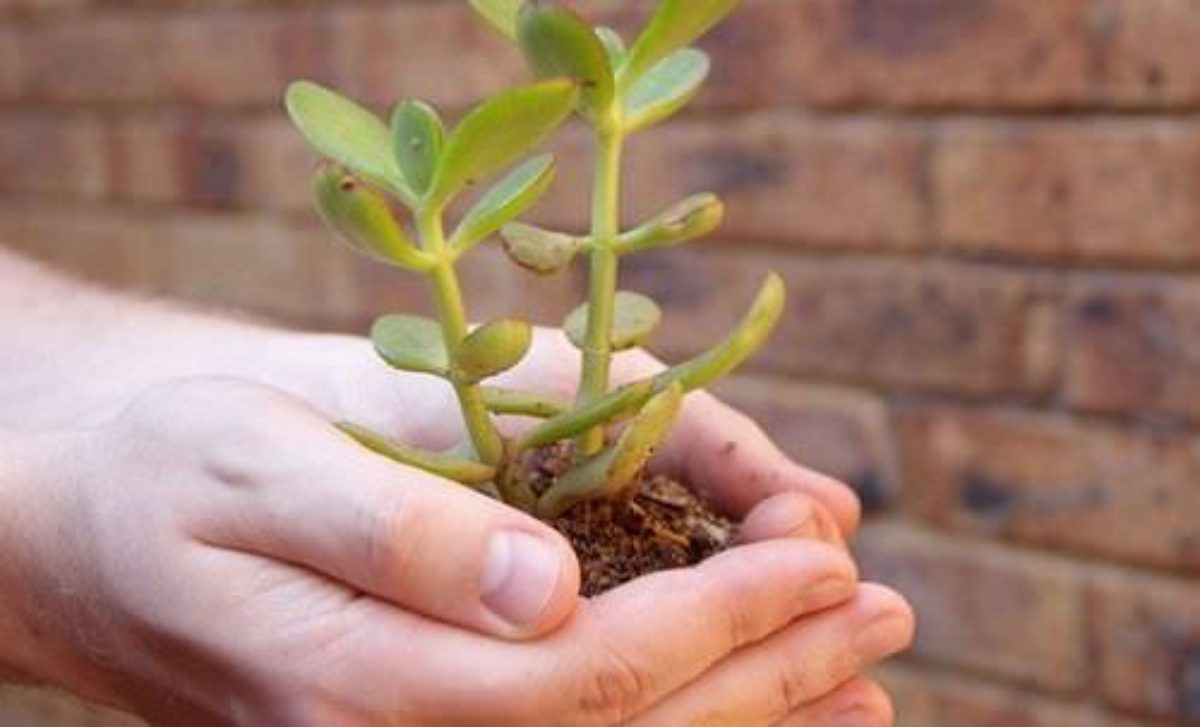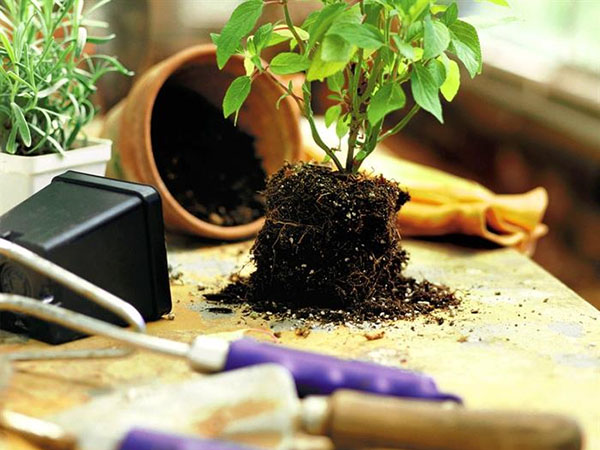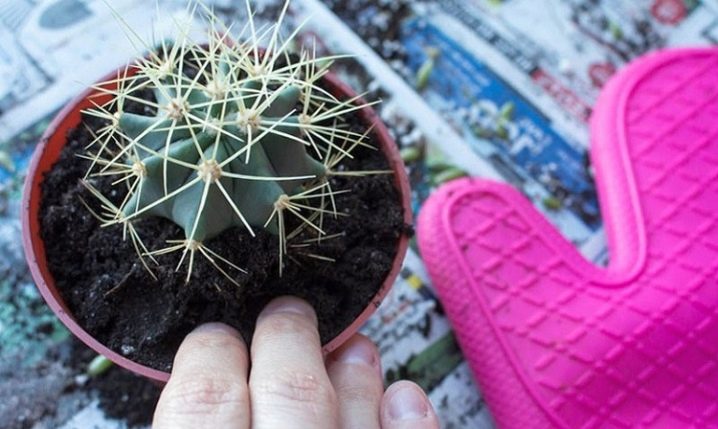How to properly transplant a cactus into another pot at home
All operations with the plant must be done carefully so as not to prick
Cactus preparation
The soil should dry well before transplanting. Watering should be stopped 3 days before the procedure for removing from the flower container.
When preparing for transplanting, you should remove the top layer of soil, turn the pot over, holding the hand protected from the cactus needles. Then, tapping the bottom of the pot on the table, knock out the earthen lump with the contents. It is not necessary to pull everything out by force, otherwise the delicate roots, which usually cling to the walls, will be damaged.
Root cleaning
It is necessary to get rid of the old soil, especially if it is store-bought. To do this, it is often enough to gently shake the plant.
If the soil mixture is very dense, then place it in warm water, rinse carefully and dry for 10 hours. So that there is no cactus tracking - hang it
Then you need to inspect the transplanted specimen (especially its root collar), cut off all damaged, dried and rotten roots with a clean tool, and treat the cut sites with sulfur powder and dry.
 You may be interested in:
You may be interested in:
Why does the Decembrist not bloom at home - what to do? For Russian latitudes, flowering plants in winter are very rare. In frosty and snowy times, house flowers ... Read more ...
Features of transplantation of different types
Transplanting cacti should be carried out taking into account the characteristics of the genus and type of cacti. Each member of the family needs a special substrate with a different structure. Tall mountain cereus will need additives containing crushed marble or granite. Mammillaria grow well in soil with the addition of leafy soil, and desert prickly pears prefer an abundance of coarse-grained river sand.
 Mammillaria transplant
Mammillaria transplant
For cacti that do not require a large amount of moisture, it is advisable to mix brick chips into the substrate. Cacti with dense white pubescence thrive in the ground with the addition of powdered eggshells and a small amount of lime. For plants with a turnip-like root system, a component such as clay is suitable.
After the roots of the plant have been processed, you can proceed with the transplant itself. Place a drainage layer (about 2 cm) on the bottom of the new pot, pour the prepared soil mixture with a small ball and put a cactus in the middle of the container. Cover the roots with soil, lightly tamp. The plant must be watered abundantly.
What to do in order not to inject
Manipulating cacti requires special care, as there is always the possibility of an injection. A thorn can remain under the skin like a splinter
Therefore, you need to secure your hands.
 It is recommended to grasp the plant with a piece of dense fabric folded in several layers, with coarse leather or rubberized gloves.
It is recommended to grasp the plant with a piece of dense fabric folded in several layers, with coarse leather or rubberized gloves.
You can use special tongs.
How to transplant and plant correctly
For the correct planting of a cactus, you need to complete all the necessary steps:
- First you need to remove the cactus from the old pot. To avoid injury from the thorns of the plant, you can use plastic tweezers. There is another way to gently remove the cactus. It is necessary to wrap the plant with paper several times, after which the pot is turned over and the succulent is carefully pulled out;
- If the cactus is "stuck" in the pot with roots, you should squeeze the pot from the sides, or separate the ground using a knife along the edges of the pot;
- If the succulent easily came out of the pot, while a significant part of the roots broke off and remained in the ground, then you need to remove the rotten areas on the roots of the cactus.All formed sections should be treated with crushed charcoal;
- In the case of a large loss of roots, when replanting a plant, it is required to add more river sand to the new soil. Also, it is noted that a container for a cactus should be chosen a size smaller than the previous one;
- If this is a group of plants and you need to plant them, carefully separate the roots of the scions from each other. You can do this with a jet of water, thereby washing the roots from the ground. This will make it easier to separate them without damaging them. After this procedure, the plant must be dried.
- Then drainage and a small amount of the substrate mixture are poured into a new container;
- After, very carefully you need to spread the roots and fill up the earth between them;
- Then the soil is poured. It should be noted that the soil should only be filled up to the root collar.
If you transplant a cactus bought in a store, then you should carefully shake off the roots from the old soil. Purchased cacti, as a rule, are planted in peat, which is why it is necessary to carefully separate the old soil from the plant roots. The soil used for commercial succulents is not suitable for growing cacti. Experienced cactus growers note that getting rid of purchased soil is much easier if it is in a dry state. And peat is eliminated by soaking the root ball in a warm liquid.
How to transplant?
The transplant procedure does not require special skills and is quite simple. It can even be entrusted to a schoolchild, having previously instructed about the danger of needles. The stages and methods of transplanting are slightly different depending on the size of the cactus, its root system and damage.
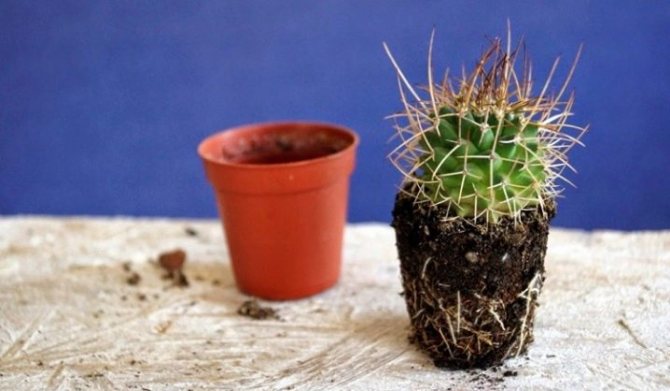
Small
Very tiny "cactus" deserve the greatest care. They are grown from seeds, building a kind of greenhouse with a film and bottom irrigation. A couple of weeks after germination, they can already be transplanted. Each plant is gently picked up with tweezers and placed in a hole, and then lightly press the soil around. Until they reach the age of one, they are transplanted as they grow, every two or three months.
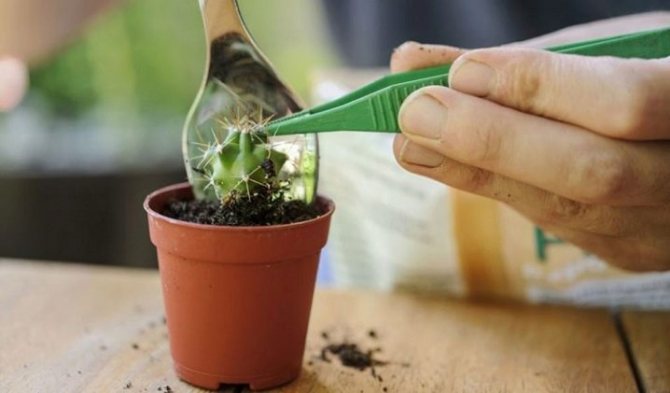
Transplanting an already grown cactus almost always follows the same step-by-step scheme.
- To begin with, the cactus is removed from the container. If the pot is plastic, you can simply wrinkle it so that the soil falls behind the walls. They also help in this matter with any thin objects.
- After removing the roots, you need to get rid of the old soil. To do this, the lumps can be picked manually. If this cannot be done or there is a risk of damaging the roots, you can resort to soaking in water. Only then the cactus must be dried in the air for a couple of days. Root cleaning is needed to assess the condition of the root system. The sooner damage is noticed, the better. The affected areas, if any, are removed with a knife or scissors. The wounds can be powdered with crushed activated carbon or simply dried.
- While the cactus dries up, fill the pot. Drainage and some soil should be placed in it. Then the cactus is placed there. It should be held in such a way that the neck is an inch below the edge of the pot. After filling the soil, you can add pebbles, sand or do without them on top.
It is believed that watering is not needed in the first 5-7 days after transplanting.
If the house is too hot or the sun is shining actively, turn on a humidifier next to the plant in the morning and evening.

Big
The larger the cactus, the greater the chance of injury. After all, there are very high or, conversely, low, but voluminous varieties. Let's consider what to do in this case.
- The pot along with the plant is laid on its side. In order not to wrinkle thorns or leaves, you need to put foam rubber or a soft cloth under them.
- The container is tapped or pushed off with chopsticks, and then carefully removed. Do not move the cactus.
- Then you need to free the roots. It is believed that perennial cacti can be transplanted while retaining most of the earthy clump.If there are no visible problems, and they did not arise during transplantation earlier, then this is quite acceptable.
Soil for cacti
Preparing soil for transplanting cacti is a complex and controversial issue, in the sense that the composition of the soil depends on many factors, for example, on the type of cactus, its age, etc. Different literatures give different recipes and methods for preparing soil for cacti. Despite the fact that they sometimes differ, each author advising this or that soil recipe, as a rule, draws on his own experience, which has had good results. The ingredients in traditional cactus soils are varied, but always the same, they are:
| Ingredients | Properties | Where to get them |
|---|---|---|
| Leaf land | Rich in nutrients, loose, lightweight, absorbs water easily. | In the spring (in April), when the snow is just melting in any birch grove or park where there are deciduous trees, snow is shoved away, old foliage and the earth is collected with a scoop. You can collect land under beeches and hazel. |
| Clay-sod land | Holds water firmly and removes nutrients more slowly | Near the garden, where the ground is overgrown with sod (dense grass), this sod is removed together with the earth with a shovel and laid in layers that can be spilled with slurry, then covered and left for at least one year. If this technology is difficult for you, then you can get this soil in a different way. It is necessary to dig up the sod and, holding by the grass, thoroughly shake off the soil from its roots. In this case, it will not be as nutritious as if pressed for a year, but the structure will meet the requirements. |
| Old greenhouse land | It is used when it is not possible to get sheet and clay-turf soil | In the garden in the garden |
| Well rotted manure (humus) | Used in microscopic amounts to add to very nutrient-poor soil for large cacti (mostly forest) | Since spring, cow dung in the garden or in the garden is laid in a compost pit and covered with leaves (birch or apple) and earth from above, after two years it is dug up and used after sterilization |
| Coarse river sand | Gives the soil looseness and porosity, is an indispensable component in any soil for all cacti | On the river, on the beach, it is necessarily well washed from fine dust; for cacti, a sand fraction of 2-3 mm is required, this is almost fine gravel. |
| Zeolite or burnt clay | Increases the porosity of the soil, helps moisture to quickly absorb, and the soil quickly dries out | Zeolite granules can be obtained from Barsik-Standard cat litter or any similar. A non-sticking filler is needed so that the granules can be washed and sieved. All small things less than 3 mm - throw out, use granules of 4-5 mm. |
| Charcoal | Charcoal from deciduous trees is used, it is used for disinfection in the form of a powder (wounded roots are sprinkled) and added in pieces to the soil, because possesses anti-rotting properties | To burn in the garden or on a vacant lot any stick made of deciduous trees, it is better to birch, break a firebrand into pieces. Crush some into powder, and leave some in small pieces and add to the soil. |
| Brick chips | Gives the soil looseness and porosity, has the ability to retain excess moisture | Use a hammer to break a red brick into crumbs, which can be found by wandering around the city or at the nearest construction site |
Before choosing a particular soil mixture, you need to know that in any case, it must meet the following requirements:
- the soil for any cacti should be loose, it is easy to let water and air pass through;
- the acidity of the soil for almost all cacti should be slightly acidic reaction better than pH = 4.5 - 6.
Types of cacti. Classification, cacti
Cacti are classified according to several biological criteria.In total, there are 11 genera of succulents and 4 categories (subfamilies). Florists who grow cacti do not accept such a division. They distinguish between their "wards" either by their natural habitat, or by the characteristics of their appearance.
Division of cacti by external signs:
- tree-like;
- similar to a liana;
- herbaceous;
- growing like a bush.
A succulent with thorns is divided into subspecies and, depending on the natural environment of its habitat, it happens:
- forest;
- deserted.
Cacti growing in a forest have almost the same appearance. They are similar to vines and are often intertwined with other types of plants, using them as a support. In nature, there are parasitic cacti that feed on other vegetation. Some types of cacti do well in open soil. True, wild plant varieties are forced to be content with soils, which have little organic matter and nutrients.

Wild cacti
All forms of thorny succulents are classified into 4 genera:
- Opuntia. Opuntia is a classic home cactus, easily distinguished from other species by its special body structure. Plants of this genus are like cakes of great thickness, the surface of which is covered with small thorns. Thorns are a kind of protection against being eaten by wild animals. The genus of prickly pears contains various types of cacti, the photos and names of which you can see in the article. There are both large and miniature prickly pears, which are often found throughout the continent. They easily endure wintering in open areas. The habitat of prickly pear succulents in Russia: Lower Volga region, Caucasus, Crimea. The flowers of the plants are large and resemble roses. Opuntia of some varieties bear fruit, their fruits can be eaten;
- Pereskievs. The smallest category of cacti, containing only one representative of the genus. Its name is spiny pereskii. Biological scientists consider this type of cactus to be transitional between deciduous plant varieties and succulents, completely covered with thorns. Place of growth of succulents of the genus Pereskievs: southern and central parts of America. Individual characteristics of the plant: long stem with small and sparse thorns, resembling a liana; large elliptical leaves; beautiful cream flowers;
- Cactus. The largest genus, which includes lush vegetation with a varied habitat (desert and forest area, comfortable home conditions). The types of cacti with a photo and a name from this genus, presented in the article, outwardly look little like each other. For example, the bodies of desert plant species are completely covered with needles. Cacti of forest varieties outwardly resemble segments connected to each other by a thin partition. There are no thorns on the surface of their leaves;
- Mauhyeny. This genus includes only one species. Its habitat is Patagonia. In terms of external characteristics, it resembles prickly pear, but differs from them in the absence of small thorns.
How to properly transplant a cactus at home
First you need to prepare the substrate and a new pot. Hold the soil mixture for half an hour in the oven or spill it with a hot solution of potassium permanganate, then let it dry: at the time of planting, the soil should be not cold, dry or barely damp.
It is necessary to prepare and sterilize the soil mixture for cacti in advance. After sterilization, the soil is covered with foil and placed in a warm, dark place for two weeks, so that microorganisms beneficial to plants develop in it.
On the day of planting, pour boiling water over the pot and fill it 1 / 6-1 / 3 of the volume with drainage material - expanded clay, pieces of broken brick, small gravel or pebbles. A piece of wine cork or broken styrofoam could be used as drainage, but unfortunately they won't add stability to the pot. On top of the drainage layer, you need to pour some substrate into the pot.
The cactus is not watered for several days before transplanting, and to make the plant easier to come out of the plastic pot, the container is squeezed from the sides with your hands. Before removing the plant from the ceramic pot, run the knife between the wall and the substrate. To remove the thorny plant without getting hurt, it is better to wear old leather gloves on your hands. It is convenient to remove a small cactus from the pot with plastic tweezers, and a large plant can be pulled out by holding it between two dishwashing sponges. Some people prefer folded paper in several layers instead of sponges.
If a healthy cactus is taken by the trunk and lifted, then it will lift the pot behind it or pull out the entire earthen lump from the pot. If the roots break off when the cactus is removed, and some of them remain in the pot, this means that the plant has problems that you did not know about. And the cause of these problems was, most likely, waterlogging or unsuitable soil for the plant.
Carefully free the roots of a healthy cactus from old substrate and drainage as much as possible. If the roots are tightly braided with an earthen lump and form a single whole with it, it is better to immediately transfer the cactus together with the lump from the pot to the pot
And it is advisable to completely clean the root system of a recently acquired cactus from the peat soil in which you bought it and which is not suitable for growing cacti. Sometimes for this you have to soak the roots in almost hot water, and only then pull out the peat fibers from them.
If the root system of the cactus is unhealthy, remove all rotten areas from it with a sharp sterile tool, treat the wounds with charcoal powder and let them dry a little. Keep in mind that the substrate for a plant with diseased roots, some of which had to be removed, should contain more sand, and the pot for a cactus that survived surgery should be smaller.
Place the cactus in the pot, gently straighten its roots and fill the remaining space with the substrate by tapping on the sides of the pot to make the soil more dense. No need to tamp and press down hard on the soil in the pot
The substrate should only reach the root collar of the cactus: if part of the stem is underground, it will start to rot, or a dry brown cork bloom will appear on the stem.
Transfer
A cactus requires a transplant when the old pot becomes small for him. It is better to do this with the onset of spring or summer, during the period of active growth, except for flowering. Also, a recently purchased flower must be transplanted with a soil replacement, but this can be done only after 10-12 days in order to allow it to acclimatize in new conditions.
Note! The frequency of transplanting depends on the variety, the age of the cactus and the occurrence of insect pests. To prepare for transplanting a few days before that, you must stop watering and spraying the plant so that the soil dries well
Then, knocking on the walls of the pot, carefully pull out the cactus with tweezers
You can also wrap the flower in several layers of paper and gently shake it out of the pot. To prepare for transplanting a few days before that, you must stop watering and spraying the plant so that the soil dries well
Then, knocking on the walls of the pot, carefully pull out the cactus with tweezers. You can also wrap the flower with several layers of paper and gently shake it out of the pot.
To prepare for transplanting, a few days before that, it is necessary to stop watering and spraying the plant so that the soil dries well. Then, knocking on the walls of the pot, carefully pull out the cactus with tweezers.
You can also wrap the flower with several layers of paper and gently shake it out of the pot.
After that, it is necessary to knead the earthen lump remaining on the roots. If the substrate does not crumble well from the roots, then you can soak them in warm water.
Cactus roots
After cleaning, the roots are carefully examined and, if damaged parts are found, cut off. For additional prophylaxis, the root system can be immersed in water at a temperature of 60 ºС for 15-20 minutes, then dried well for a couple of days.
After the necessary pot is selected, you can start the transplant process.
Note! The pot should be large enough to accommodate the root system, but not too large or leave a lot of extra space. Drainage is laid out on the bottom of the pot with a layer of 3-5 cm, a small amount of the prepared substrate is poured on top
After that, the cactus is carefully lowered into the pot, the roots are straightened and the soil mixture is poured. The root collar of the plant should not be covered with earth, remaining above its level. During planting, the substrate needs to be tamped a little, as a result of which it should turn out 1 cm below the container level
Drainage is laid out at the bottom of the pot with a layer of 3-5 cm, a small amount of the prepared substrate is poured out on top. After that, the cactus is carefully lowered into the pot, the roots are straightened and the soil mixture is poured. The root collar of the plant should not be covered with earth, remaining above its level. During planting, the substrate needs to be tamped a little, as a result of which it should turn out 1 cm below the container level.
The first few days after transplanting, the flower must undergo acclimatization in new conditions. You should not put it on a windowsill where the bright sun is shining, it is better to leave it in a shaded place. You can water the plant after 5-7 days. The water should be moderately warm (temperature 32-35 ºС). If the soil layer settles after watering, then you can add some more substrate to the pot.
Cactus babies
If the transplant took place in the winter, then the first watering is done no earlier than 2-3 weeks. The room temperature should be 20-25 ºС. Fertilization is possible one month after transplanting. To do this, use mineral complexes containing potassium, phosphorus, nitrogen and trace elements.
For your information! Reproduction of cacti occurs with the help of seeds, which is very long and laborious, and flower shoots. Cactus babies have barely noticeable roots that root in the ground in the same way as adult flowers.
When a question arises, how to plant a cactus, you can safely apply the transplanting rules described above.
Watering conditions
 The most active time for watering cacti is spring and early summer. As winter approaches, you should begin to reduce the frequency of watering. In winter, most cacti do not need water, provided they are kept at low temperatures in the range of 5-15 degrees. Lack of watering in winter is the key to successful flowering of a cactus in the spring and summer. Tap water is not suitable for cacti. Whenever possible, collected rainwater or melted snow is used to water the cactus. It triggers chemical reactions and provides nutrients to the soil. Do not water the cacti with cold water.
The most active time for watering cacti is spring and early summer. As winter approaches, you should begin to reduce the frequency of watering. In winter, most cacti do not need water, provided they are kept at low temperatures in the range of 5-15 degrees. Lack of watering in winter is the key to successful flowering of a cactus in the spring and summer. Tap water is not suitable for cacti. Whenever possible, collected rainwater or melted snow is used to water the cactus. It triggers chemical reactions and provides nutrients to the soil. Do not water the cacti with cold water.
Watering methods
Most of the cultivated cacti are desert dwellers, so they can be watered in a pan. Potted plants should be placed in a saucer of water so that they absorb moisture through the roots. Another method of watering cacti is to apply water to the surface of the soil. In this case, the amount of water will depend on a number of factors: heat, direct light and planting. Succulents need watering when the soil is completely dry. To find out if a cactus needs water, you can insert a pencil all the way to the base of the pot. If wet soil sticks to it, it's not time to water.
Possible problems
Once transplanted, the cactus may look great. However, even seemingly healthy plants need to be inspected periodically. After all, the sooner you discover a problem, the easier it is to fix it. Moreover, the problems may relate not only to the state of the plant, but also to the soil.For example, it can sag on one side. This is due to the uneven filling of the pot. To avoid subsidence, the pot must be shaken periodically while filling, but never tamped.

When examining a cactus, you should be alerted by some points.
- The appearance of wrinkles. If the trunk is still hard, it may be lacking moisture. If the trunk is soft, this could be the onset of the disease.
- Lack of growth. If growth has stagnated or not, the soil may be lacking nutrients. You can use fertilizers (except nitrogenous).
- Cracks. They are usually associated with an oversupply of fertilizing.
- Spots, discoloration, plaque. All this can be a sign of an infectious or bacterial disease, as well as the appearance of parasites.
- Loss of elasticity. Sometimes a tall cactus can begin to lose its shape and bend to the side. Most often, in such cases, there is a problem with the roots - they are the most vulnerable. For example, they can rot from excessive watering.
If the appearance of the cactus has changed, do not wait. You need to immediately transplant, completely replacing the soil. At the same time, the cactus itself also gets rid of the affected areas and is processed.
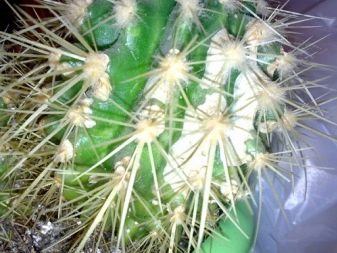

What needs to be prepared for transplant
As already mentioned, you need to be very careful with cacti during the transplanting process. In rare cases, the plant will survive if something breaks or there is at least a small scratch during the planting. If the root system is damaged, in no case should it come into contact with moisture, otherwise the plant will quickly rot.
It will not be superfluous to make the first cactus transplant in your life under the supervision of an experienced specialist in order to avoid possible consequences. But we tried to collect for you all the information you need about the transplant, so it's up to you to decide whether to ask an experienced cactologist for help or not.
Choosing a pot and soil for transplanting
One of the first mistakes that people who are unfamiliar with breeding cacti make is that if you do not pay enough attention to the choice of a pot and soil for a plant, the plant will not be able to develop normally and will begin to wither.
First of all, what you need to take care of are transplant pots. The first thing to do with the purchased pot (as already mentioned in this article - choose the pot based on the size of the root system), rinse and disinfect it. After manipulating the water, you need to dry the pot.
In advance, you need to prepare the soil mixture. Experienced cactus experts advise using moist soil.

For the cactus transplant procedure, you will need:
- Expanded clay. It can be replaced with crushed bricks.
- Sand - it must be washed and dried. River sand can be used.
- Finely crushed crushed stone.
- Soil mixture.
Special attention should be paid to the soil mixture. It should be loose to allow air to pass through easily.
Caring for a cactus after transplanting
It is not difficult to take care of a cactus after transplanting, if the gardener has previously dealt with these exotic plants. The basic rules practically do not change, as well as the requirements for the microclimate, but there are a number of nuances:
- In the first 2 weeks after transplanting, the cactus should be watered abundantly. If the usual frequency of irrigation is 1 time in 5 days, then in this case it is necessary to reduce the gap to 1 time in 3 days.
- Additional feeding is needed only on the day of disembarkation.
- The first week you need to protect the plant from drafts and sudden changes in temperature.
Transplanting cacti causes difficulties for gardeners only for the first time. In fact, changing the pot and soil for this plant is no more difficult than for any other, if you get down to business and prepare well. The main thing is not to forget about leaving after transplantation and to observe safety precautions.
How to care for a cactus
The first thing to understand is that you cannot water a newly transplanted cactus.No matter how carefully you transplant, the filamentous roots will still be injured. Due to these injuries, if the roots do not recover and come into contact with moisture, the process of decay will begin and the plant will be destroyed.
You need to water the cactus a week after transplanting, but this is if you did everything correctly, in cases where the root system was severely damaged, the first watering should be done only ten days after transplanting. Then the plant will rest and recover and the decay process will definitely not be scary.
Cacti should not be watered abundantly, a small amount of water will be enough for the plant, the main thing is that it is warm.
It is also recommended not to put the newly transplanted cactus in the sun, it can get sunburn. The ideal place for him would be the penumbra.
As you can see, transplanting a cactus is a very simple process, although it requires caution. And if you still have any questions, we recommend that you familiarize yourself with this video :.


